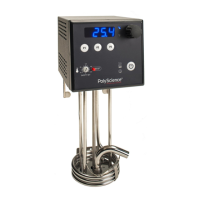Application Notes
At a fluid's low temperature extreme:
1. The presence of ice or slush adversely affects temperature stability.
2. A viscosity above 10 centistokes adversely affects temperature uniformity.
3. A high fluid viscosity and high pump speed adds heat to the fluid being pumped.
At a fluid's temperature above ambient without refrigeration:
1. To avoid friction heating of the fluid, the viscosity of the fluid should be 10 centistokes or less
and within 15°C of room temperature.
2. Heat loss should be encouraged by uncovering the fluid and lowering the pump speed.
At fluid's high temperature extreme:
1. Heat loss from vapor adversely affects temperature stability.
2. To prevent the accumulation of vapors inside the room, the reservoir may need to be placed
in a fume hood.
3. Use a cover and/or floating hollow balls to help prevent heat and vapor loss.
4. Replenish fluid lost from vapor frequently.
Section 9 - Service and Technical Support
If you have followed the troubleshooting steps outlined in Section 7 and your Circulator still fails to
operate properly, contact the supplier from whom the unit was purchased. Have the following
information available for the customer service person:
— Model, Serial Number, and Voltage (from back panel label)
— Date of purchase and purchase order number
— Supplier’s order number or invoice number
— A summary of the problem

